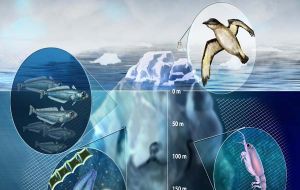MercoPress. South Atlantic News Agency
Antarctic icebergs are “ecological hotspots” for ocean life
 Icebergs hold trapped terrestrial material, which they release far out at sea as they melt
Icebergs hold trapped terrestrial material, which they release far out at sea as they melt Drifting icebergs are "ecological hotspots" that enable the surrounding waters to absorb an increased volume of carbon dioxide, a study suggests. United States scientists found that minerals released from the melting ice triggered blooms of CO2-absorbing phytoplankton, reports BBC.
These microscopic plants were then eaten by krill, whose waste material containing the carbon sank to the ocean floor. The findings are published in the online journal Science Express. The study, carried out in the Southern Ocean's Weddell Sea in December 2005, has helped researchers understand the impact of free-floating icebergs on the marine environment. The number of icebergs found in waters around Antarctica has increased in recent decades as a result of global warming, the researchers wrote in the paper. "We got a satellite image that covered roughly 11,000 sq km, and counted the number of icebergs within that area," explained Ken Smith, an oceanographer from Monterey Bay Aquarium Research Institute, California. "We had almost 1,000 icebergs." The team focused its attention on two icebergs, one measuring 2km by 0.5km and another 21km in length and 5km wide. Using instruments that included a trawl net and a remotely operated vehicle (ROV) with a video camera, the researchers sampled waters from the ice blocks to 9km away. They found a "substantial enrichment" of minerals, phytoplankton, krill and seabirds in the surrounding water up to 3.7km away compared with areas with no icebergs. "These results suggest that free-drifting icebergs can substantially impact the (open sea) ecosystem of the Southern Ocean and can serve as areas of enhanced production and sequestration of organic carbon to the deep sea," the scientists wrote.




Top Comments
Disclaimer & comment rulesCommenting for this story is now closed.
If you have a Facebook account, become a fan and comment on our Facebook Page!